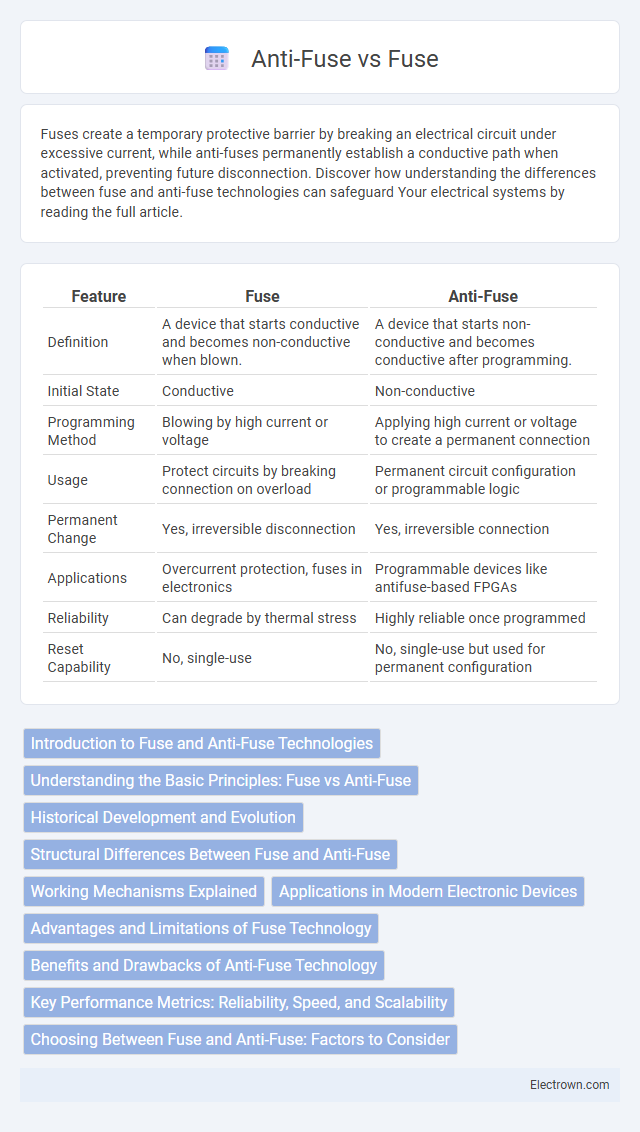Fuses create a temporary protective barrier by breaking an electrical circuit under excessive current, while anti-fuses permanently establish a conductive path when activated, preventing future disconnection. Discover how understanding the differences between fuse and anti-fuse technologies can safeguard Your electrical systems by reading the full article.
Table of Comparison
| Feature | Fuse | Anti-Fuse |
|---|---|---|
| Definition | A device that starts conductive and becomes non-conductive when blown. | A device that starts non-conductive and becomes conductive after programming. |
| Initial State | Conductive | Non-conductive |
| Programming Method | Blowing by high current or voltage | Applying high current or voltage to create a permanent connection |
| Usage | Protect circuits by breaking connection on overload | Permanent circuit configuration or programmable logic |
| Permanent Change | Yes, irreversible disconnection | Yes, irreversible connection |
| Applications | Overcurrent protection, fuses in electronics | Programmable devices like antifuse-based FPGAs |
| Reliability | Can degrade by thermal stress | Highly reliable once programmed |
| Reset Capability | No, single-use | No, single-use but used for permanent configuration |
Introduction to Fuse and Anti-Fuse Technologies
Fuse and anti-fuse technologies serve as critical components in electronic circuits for programmable and one-time configurable interconnections. Fuse technology operates by physically breaking a conductive link to open a circuit path, enabling device customization or protection after manufacturing. Anti-fuse technology creates a permanent electrical connection by forming a short between two terminals, allowing reliable programming for applications like field-programmable gate arrays (FPGAs) and secure device configuration.
Understanding the Basic Principles: Fuse vs Anti-Fuse
Fuse devices operate by creating a permanent open circuit when subjected to excessive current, effectively interrupting the flow to protect electronic circuits. Anti-fuse technology, in contrast, starts as an open circuit and permanently closes to form a conductive path when a specific programming voltage is applied, enabling irreversible connections. Both mechanisms are critical in semiconductor and integrated circuit applications for ensuring circuit protection and customization.
Historical Development and Evolution
Fuse technology emerged early in semiconductor history as a simple, reversible method for circuit protection and customization, evolving from basic wire fuses to sophisticated integrated fuses in microchips. Anti-fuse technology was introduced later, providing a one-time programmable solution that permanently changes circuit connections, catering to increased demand for secure and tamper-proof devices. Your choice between fuse and anti-fuse depends on factors like desired permanence, programming flexibility, and application-specific reliability requirements in evolving electronic systems.
Structural Differences Between Fuse and Anti-Fuse
Fuse and anti-fuse devices differ fundamentally in their structural composition; a fuse contains a thin metal wire or strip designed to melt and break the circuit under excessive current conditions, while an anti-fuse consists of two conductive layers separated by an insulating material that becomes permanently conductive when a high voltage is applied. The fuse operates as a protective element that physically disconnects the circuit, whereas the anti-fuse creates a permanent electrical connection once triggered. These contrasting structures result in fuses being reversible and replaceable after failure, contrasting with the one-time programmable and irreversible nature of anti-fuses.
Working Mechanisms Explained
Fuse technology operates by creating or breaking a physical connection under electrical current, enabling or disabling circuits through a controlled melting process. Anti-fuse technology, in contrast, initiates an irreversible connection by forming a conductive link when voltage is applied, effectively changing from a high-resistance to a low-resistance state. Understanding these distinct working mechanisms helps you choose the appropriate technology for applications requiring either temporary or permanent circuit reconfiguration.
Applications in Modern Electronic Devices
Fuse technology is widely used in consumer electronics and power management circuits to provide reversible overcurrent protection, ensuring reliability and safety in devices such as smartphones and laptops. Anti-fuse technology, employed primarily in programmable logic devices like FPGAs and microcontrollers, offers permanent, one-time programmable connections ideal for secure and tamper-resistant applications. Your choice between fuse and anti-fuse components depends on whether you require reconfigurable circuit protection or a fixed, irreversible logic configuration in modern electronic devices.
Advantages and Limitations of Fuse Technology
Fuse technology offers simple and reliable circuit protection by physically breaking a conductive path when excessive current occurs, ensuring device safety and preventing damage. It provides clear failure indication and low cost, making it suitable for various applications; however, it requires replacement after activation and may introduce slower response times compared to semiconductor-based alternatives. Limitations include limited programmability and potential inefficiency for high-speed or repetitive switching scenarios.
Benefits and Drawbacks of Anti-Fuse Technology
Anti-fuse technology offers benefits such as permanent and reliable connections with low resistance, making it ideal for applications requiring secure, tamper-resistant circuitry. However, its irreversible nature means once programmed, the circuit cannot be reconfigured, limiting flexibility compared to fuse technology. Your choice should weigh the trade-offs between durability and adjustability to meet specific design requirements.
Key Performance Metrics: Reliability, Speed, and Scalability
Fuse technology offers high-speed operation with moderate reliability suitable for temporary programmable logic, while Anti-Fuse excels in permanent reliability and data retention under harsh conditions. Fuse circuits may experience degradation due to repeated programming, affecting long-term reliability, whereas Anti-Fuse devices provide unconditional scalability with one-time irreversible programming, ideal for secure applications. Your choice depends on prioritizing either faster reconfigurability with limited cycles or permanent, highly reliable programming in large-scale integrated circuits.
Choosing Between Fuse and Anti-Fuse: Factors to Consider
Choosing between fuse and anti-fuse technology depends largely on application requirements such as reconfigurability, reliability, and power consumption. Fuse devices offer reprogrammability and easier testing, making them ideal for applications needing flexibility and iterative development. Anti-fuse technology provides permanently programmed connections with higher reliability and resistance to radiation, suitable for secure and long-term use in aerospace or military systems.
Fuse vs Anti-Fuse Infographic

 electrown.com
electrown.com